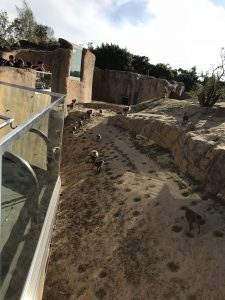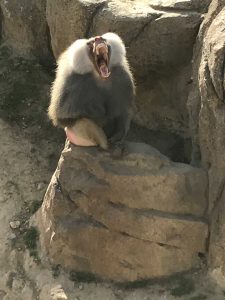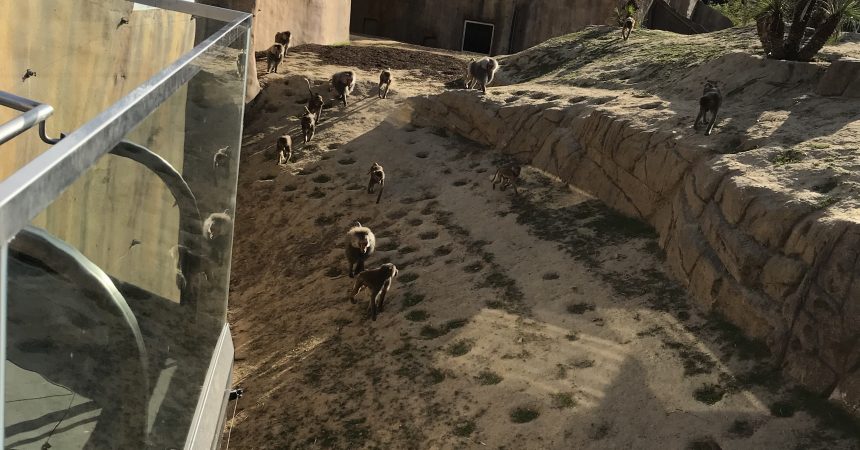Zoo Internquest is a seven week career exploration program for San Diego County high school juniors and seniors. Students have the unique opportunity to meet professionals working for the San Diego Zoo, Safari park, and Institute for Conservation Research, learn about their jobs, and then blog about their experience online. Follow their adventures here on the Zoo’s website!
 This past Thursday, I had the chance to observe a group of Hamadryas baboons while talking with their trainer and caretaker, Dustin Black. Mr. Black has been working at the San Diego Zoo for nearly 25 years, but only nine months have been spent with the baboons. As he described, caring for this group of what is now 20 Hamadryas baboons has been challenging, especially considering the baboons initial lack of training. However, after many years of zoo keeping, this was a challenge Mr. Black was ready to take on. After spending an afternoon with these baboons, I could definitely see how this job could be challenging; the baboons often reminded me of moody teenagers!
This past Thursday, I had the chance to observe a group of Hamadryas baboons while talking with their trainer and caretaker, Dustin Black. Mr. Black has been working at the San Diego Zoo for nearly 25 years, but only nine months have been spent with the baboons. As he described, caring for this group of what is now 20 Hamadryas baboons has been challenging, especially considering the baboons initial lack of training. However, after many years of zoo keeping, this was a challenge Mr. Black was ready to take on. After spending an afternoon with these baboons, I could definitely see how this job could be challenging; the baboons often reminded me of moody teenagers!
When I first arrived at the exhibit, I could see a rocky outcropping that was almost like a mini-mountain jutting out from the flat ground below. On top of this outcropping were three baboons, and being the usual me, I was already getting way too excited. It was not long until the other 17 of the group came around the corner. I remember letting out an elongated, “Woah.” when I saw them. They had been taking laps around the exhibit and weren’t done yet. For the near entirety of our time there, the baboons continued to walk around the exhibit, going in one big circle. During one of these laps I got a shot of the troop turning the corner.
 Every now and then they would take breaks to groom each other or simply mess with the plants. Some of the baboons were tearing off branches and leaves from the already barren trees while others were digging at visible holes in the ground. It was during one of these small rest times that I was able to get a shot of one of the baboons yawning.
Every now and then they would take breaks to groom each other or simply mess with the plants. Some of the baboons were tearing off branches and leaves from the already barren trees while others were digging at visible holes in the ground. It was during one of these small rest times that I was able to get a shot of one of the baboons yawning.
During our last ten minutes with the troop, the baboons started acting up. This was also when most of the “moody teenager” comments were made about them. The baboons started to act antsy as if something had startled them, and soon they started running around the circle, rather than their normal walk. The females stopped after about one lap, but the males continued. By then the gelada baboons were getting riled up as well, screeching and hollering for everyone to hear. Eventually one of the male Hamadryas baboons started screeching himself, still running of course. I remember seeing the long, puffy hair of the males bouncing up and down as they ran, a sight that was honestly quite graceful. The other males came to a stop around the screeching male, and lucky for us they stopped in our sight.The screeching male was turning in circles, screaming at any male who got near him before running off. The other males pursued and the chase was on. As the male ran around the exhibit, the females simply sat and watched through all the commotion. The situation ended with the silly sight of another baboon jumping onto the screeching baboon and simply standing there until he went quiet. Mr. Black said it wasn’t abnormal for the baboons to get into scrapes or fights, however he also commented that it wasn’t abnormal for things to go right back to normal afterwards. Give this behavior, Mr. Black described their society as being very explosive and extreme. Once all of this was done, someone remarked that it would make excellent material for a teen drama novel.
Mr. Black’s work with the baboons is another step in helping to promote appreciation and concern for animals, such as the baboons, as well as their conservation. Even though Thursday’s session flew by, it was still as fun as ever! All in all, it will be an experience that I will never forget. After all, how could I ever forget about the animals that reminded me of moody teenagers, Hamadryas baboons.
Amber, Real World Team
Week Three, Winter 2018


